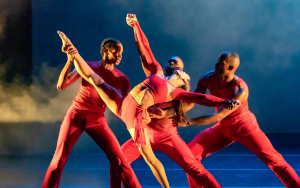Aycock Auditorium was full almost to the brim of students and community members alike on the second evening of The Marriage of Figaro, performed by the UNCG School of Music, Theatre, and Dance and conducted, produced, and directed by David Holley.
This opera’s design theme was based on the popular show Downton Abbey. It was set in the same time period, with strong character parallels between the opera and the TV show. The set and the costumes both matched the theme perfectly. The set, designed by Randall J. McMullen was stellar. Each act was set in a different room of the count’s castle, and so the set changed slightly for each act. It was genius, really. Each set had portions of walls, whether a door and frame, a bookshelf, or an armoire; these were placed to outline the room. Each of these pieces, and every other set piece, looked authentic for the time period in which the opera was set. The costumes, designed by Vandy Scoates, were equally authentic to the time and fit the characters’ personalities well.
Jacob Kato, who sang the title role, has a rich baritone voice but was occasionally difficult to hear when singing the arias over the orchestra . Susanna was played by Evangelia Leontis who delivered the role with wonderful sass. Leontis has a beautiful, soaring soprano sound that cut easily through the orchestra and carried throughout the hall. John Jones, the Dr. Bartolo, has a booming, low bass-baritone. I really enjoyed listening to him. Gretchen Krupp, who played Marcellina, is an incredible mezzo-soprano. Her voice has a certain ringing, spinning quality to it that was lovely; I could have listened to her sing for hours. Sarah Love Taylor, mezzo-soprano, as Cherubino, was delightful in character; her antics left the crowd laughing. Taylor also had easy access to her upper range for such arias as “Voi, che sapete.”
Matthew Arnold was not only a wonderful singer but also quite good at playing the lustful, somewhat creepy Count Almaviva. Like Kato, he was occasionally difficult to hear over the orchestra, but otherwise his rich baritone voice carried quite easily out to the audience. Don Basilio, played by the bright, high tenor Jonathan Ray, is one of my favorite characters; he was portrayed as an exuberant brown-noser. Lydia Pion, Countess Almaviva, has a very beautiful, mature soprano voice. Her aria “Porgi, amor, qualche ristoro” was simply lovely. Baritone Andreas Nasser did a wonderful job portraying Antonio, the show’s drunk. James Smidt, who played Don Curzio, was a quiet tenor who was fairly difficult to hear over the orchestra, but he did excellent work with his character – particularly his amusing portrayal of the stuttering judge was far from a commanding presence. Finally, Barbarina, played by Holly Curtis, was a wonderfully wicked character. Curtis has a nice, ringing soprano voice that was very pleasant to hear.
The entire cast had excellent diction, which made it very easy for the audience to understand and follow the recitatives. When sung, English can be challenging to understand, but the recitatives performed by each character were very clear.
An interesting aspect of this production was that the arias were in the original Italian but the recitatives were in English. I am not sure if this is common practice (I have never seen it done this way), but it definitely helped the audience understand what was happening in the plot. There was a screen above the stage onto which English translations were projected; this worked off and on throughout the show.
The orchestra sounded wonderful. The instrumentalists were tight and well rehearsed, and made nary a mistake that I could hear. Again, it was sometimes difficult to hear the male singers over the orchestra during the arias (the recitative was accompanied by only harpsichord), but overall this was an incredible production. I cannot wait until the next UNCG opera!
The Marriage of Figaro will be repeated on the afternoon of April 6. For details, see the sidebar.











